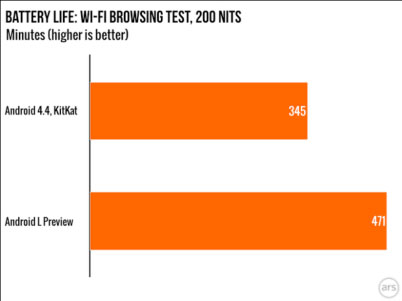As the year winds down, the developer community can look forward to new operating systems from Apple, Android, and Microsoft. We’ve covered the forthcoming IOS 8 upgrade and Windows has taken a different approach, updating their Windows 8.1 consistently without renaming the OS. This leaves the upcoming Android L. Android recently released the Android L Developer preview, a sneak peak at the latest version of the OS, available for the Nexus 5 and the 2013 Wi-Fi Nexus 7. We took a look to assess the ins and outs of the platform.
The biggest development in the Android L is an aesthetic: the shift from the recommended Holo visual theme to Material Design. Like flat design, Material Design involves a simple, vibrant, non-skeuomorphic visual scheme. Unlike flat design, Material Design is about creating a realistic cyber universe. Material is a metaphor. The idea of space within the user interface which is “inspired by the study of paper and ink yet technology advanced and open to imagination and magic.” (via Google) In other words, it’s an interface which is realistic and has intuitive rules within its own world, but still makes things easier when it can with creative gestures and transitions. The key to creating a realistic digital-space is to have consistent, fundamental rules of light, surface and movement. For more on Material Design, check out Google’s introduction to the concept.
The notification tray received a major renovation. Rather than keeping two trays for alerts and quick settings, the two are now presented in one unified notification tray. Dragging down from the top of the screen pulls out notifications, then dragging down on the notifications screen reveals a layer of quick settings.
The lock screen also received an update, displaying notifications front and center, allowing easy access directly from the lock screen. The updated lock screen also makes access to functions easier through gesture: a swipe up unlocks the device, a swipe left opens the camera, a swipe right (on phones) opens the dialer.
Android’s Project Volta was designed to optimize the OS’s performance on smartphones to improve battery life. Project Volta follows a pattern of projects run by Google focused on addressing weaknesses of the previous platform, such as Project Butter, which aimed to make Android’s UI animations run at 60 fps, and Project Svelte, an effort to get the OS to run on 512MB of RAM. In previous versions, when the OS is engaged in a process for one second, it burns two minutes of standby time. To address this, Project Volta includes the development of a “JobScheduler” API which allows the OS to batch unimportant app requests, and gives developers the option to delay housekeeping functions on their apps until the device is plugged in. ArsTechnica did a study of the Android L Preview battery life versus Android 4.4 KitKat and found that Android L Preview had 36% more battery life.
Via Ars Technica
Another major move in the Android L Preview is the transition of the default run-time from Dalvik to ART, which aims to save battery life and yield a faster, more efficient performance. Animations and scrolling felt both faster and smoother, but there were some bugs with the multitasking view and notification tray which one can imagine will be fixed in the final version of the OS.
App compatibility with the new OS fluctuates, some work fine in the Android L Beta, while others don’t work at all, including Twitter, Dropbox, and Google Docs. Of course, we expect much of this to be ironed out in the final version of the OS. The bottom line for Android developers is that Android L represents a major improvement in battery life, aesthetics and performance, which is good for business.
At Mystic Media, we’re highly experienced in the Android app development field, with a thorough and continually evolving perspective on the ins and outs of the platform. Contact us today by clicking here or by phone at 801.994.6815

